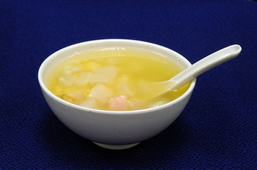
Food Safety Focus (37th Issue, August 2009) – Incident in Focus
Boric Acid and Borax in Food
Reported by Ms. Janny MA, Scientific Officer,
Risk Assessment Section,
Centre for Food Safety
The Centre for Food Safety (CFS) has recently released the results of food surveillance on Hong Kong-style desserts. Results showed that a root starch jelly sample and three desserts containing root starch jelly were found to contain boric acid, a non-permitted preservative, at levels ranging from 830 to 11 000 mg/kg. This article provides more food safety information on boric acid and borax in food.

Illustration: Sweet soup containing root starch jelly
What are Boric Acid and Borax?
Boric acid (H 3 BO 3 ) and borax (Na 2 B 4 O 7 ‧10H 2 O) are common boron-containing compounds.
|
Boron is a non-metallic element which never occurs in nature by itself. It mainly exists in the form of borates, compounds formed after combining with other substances, in the environment. Boron is also an essential micronutrient for optimum growth in plants. However, little is known about the function of boron in humans. |
Boric acid and borax occur naturally in water and soil. They can be used in a wide range of consumer products, including preservatives, glass, fire retardants and pesticides etc.
Boric Acid and Borax in Food
Naturally Occurring
Boron occurs naturally in food as borate (B 4 O 7 2-) or boric acid. The richest sources of boron include fruits, leafy vegetables, legumes, and nuts. Wine, cider and beer also contain high levels of boron. Dairy products, fish, meats, and most grains are poor sources. (Table 1)
Table 1. Reported levels of boron in some foods (World Health Organization, 1998)
| Food Category | Food Item | Level of Boron (mg/kg; fresh weight basis, unless otherwise specified) |
|---|---|---|
| Fruits | Apple, red with peel, raw | 2.38-2.73 |
| Banana, raw | 3.72 | |
| Nuts | Almonds | 23 |
| Peanuts | 13.8-18 | |
| Beverages | Beer | 0.13-1.8 mg/L |
| Wine | 3.5 mg/L | |
| Cereal grain products | Enriched white bread | 0.20-0.48 |
| Instant white rice | ≤0.015 |
For the general population, the greatest boron exposure comes from the oral intake of food, mainly fruits and vegetables. The World Health Organization (WHO) has estimated the average daily intake of the population is about 1.2 mg boron from diet, which falls well within the safe range of population mean intakes for adults (1.0-13 mg boron/day) suggested by the WHO.
As Food Additive
Boric acid and borax have long been used as additive in various foods. Since boric acid and borax are effective against yeasts, and to a much lesser extent, against moulds and bacteria, they can be used to preserve food products. In addition, both of these additives can be used to increase the elasticity and crispiness of foods as well as prevent shrimps from darkening.
According to literature, in the early 1900s, some scientists started questioning the safety of the use of large amounts of boric acid and borax in foods. By the mid-1920s, many countries began legislating against the use of these additives in foods due to their toxicity. However, during the Second World War, there was serious food shortage, and restrictions on the use of food preservatives including the application of boric acid and borax in foods were eased. After the War, restrictions on the use of these additives in foods were gradually re-imposed. Nowadays, their uses in food are not permitted in many countries such as Mainland China, Australia, New Zealand and Canada .
In 1961, the Joint FAO/WHO Expert Committee on Food Additives (JECFA) concluded that boric acid and borax were not suitable for use as food additive. However, they are still permitted to be used in caviar in the European Union.
Health Effects of Boric Acid and Borax
At low concentrations, borax can be converted to boric acid in body prior to absorption.
In humans, it is believed that adverse reactions associated with low doses of boric acid per day are unlikely to occur. However, exposure to large amounts of boric acid over a short period of time can affect the stomach, bowels, liver, kidney, and brain, and may even lead to death.
Animal studies indicated that excessive ingestion of boric acid over a prolonged period of time may cause adverse developmental and reproductive effects. Testicular lesions and impaired fertility have been observed in experimental animals given boric acid in the diet. However, there is no evidence that boric acid is toxic to the genes or carcinogenic.
Tolerable Daily Intake Level
The WHO has established a Tolerable Daily Intake (TDI) of 0.16 mg boron/kg bw during the development of the guidelines for drinking water.
|
Key Points to Note
|
Local Situation
In Hong Kong, under the Preservatives in Food Regulation, boric acid and borax are not permitted preservatives in food.
In recent years, boric acid has been detected in fresh pork, fish balls, rice dumplings and Chinese dim sums including shrimp dumplings etc. From 1 January 2007 to 30 June 2009, the CFS tested some 2 670 food samples for boric acid, in which six were found to have used boric acid illegally.
Advice to Public
- Obtain food from reliable sources.
- Maintain a balanced diet.
Advice to Trade
- Do not use boric acid or borax in food.
Further information
CFS Risk in Brief on "Use of Boric Acid and Borax in Food".

